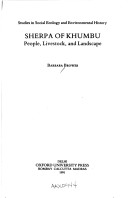In the three and a half decades since Nepal opened its borders the Sherpa world has changed irreversibly. Becoming a part of the rest the world and being defined as a natural park have brought new pressures on people and the land, and have vitally affected both the traditional life of the Sherpa people and the fragile high mountain environment of Khumbu. This study, based on extensive fieldwork, looks at animal management in Sagarmatha National Park in the context of Sherpa subsistance, demonstrating the intricacy of man-land relationship, the adaptability of traditional people and the range of considerations that must be taken into account in any attempt to modify traditional land use practices. The Khumbu landscape is graphically described and the human role in modifying the natural landscape is explored. Sherpa history and economy are discussed as are the substantial changes that the traditional life of Khumbu has undergone in the past few decades. Livestock provides a focal point for this wide ranging investigation and the cattle economy in particular is described in some detail.
Although focusing on the Sherpa its relevance should stretch beyond its immediate subject to the study of all traditional societies subject to the pressures of change and the debate on the apparent hiatus between preservation of the environment and the legitimate rights of the people who depend upon it for a livelihood. This work should be of interest to anthropologists, geographers and scholars of agriculture and environmental studies.
- ISBN10 0195626141
- ISBN13 9780195626148
- Publish Date 19 December 1991
- Publish Status Out of Print
- Out of Print 12 January 1995
- Publish Country IN
- Imprint OUP India
- Format Hardcover
- Pages 226
- Language English
